
Dedicated to promoting and preserving the very best of classical and contemporary saxophone literature.
Bulletin Board
Call for Compositions!
KPH is wanting to promote and publish mixed ensemble music with saxophone. In particular, saxophone, cello, piano trio. This is an under-explored instrumentation which is growing in popularity. Please see our Submissions page for more information.
![]()
![]()
Haaheim, Kip – The Clinging Fire for saxophone quartet (1998) – 14 minutes PROGRAM NOTES: One of my favorite scales can be represented by the pitches C, Db, E, F, G#, and A. This particular collection of notes possesses a unique kind of musical symmetry that evenly distributes minor seconds and minor thirds through the octave. READ MORE Sample Scores: Movement I, Movement II, Movement III Recordings: America’s Millennium Tribute to Adolphe Sax, volume 14 (AUR CD 3131)
|
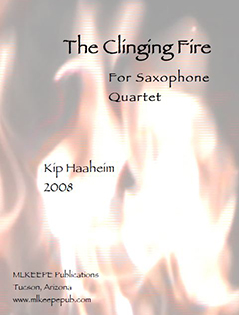 |
| Price: $35.00 (US Dollars) |
Krause, Drew – Chat Farm for saxophone quartet and recorded sound (2007). PROGRAM NOTES: Chat Farm waswritten for the Presidio Quartet, to whom it is dedicated. The piece is comprised of several non-repeating sections of contrasting texture and varying, but related, tempi. READ MORE Sample Scores: Beginning, Middle, End |
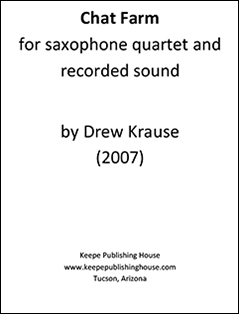 |
| Physical Copy Price: $45.00 | |
| Digital Copy Price: $38.25 (US Dollars) Originally $45.00 |
Larsen, David - Garden Sonata for saxophone quartet (2010) PROGRAM NOTES: I wrote Garden Sonata as the bridal march for my wedding. It was originally performed by flute, clarinet, and string trio. This piece is a text book example of the classic “sonata allegro” form including a development and coda section. The piece moves through more than 4 different keys, so the ensemble will need to work to tune the more difficult keys. The piece should be played quickly and smoothly with a gentle lilt. Don’t be afraid of big dynamic contrast. Sample Score Page I, Sample Score Page II Listen:Price: $30 USD (Digital Only) |
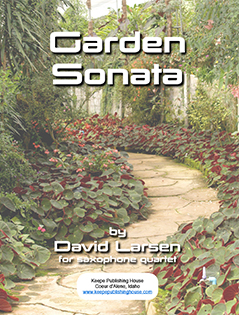 |
Larsen, David - Metro for saxophone quartet (2013) – 2:48 Minutes (Depending on solos) Program Notes: Metro is a funk piece for saxophone quartet. It has a simple groove and is based on crunchy harmonies and wild extremes. It has a harmonized melody and a bridge with a lot of dynamic contrast. The open solo section is based largely on an Eb Blues scale and can be improvised over using few notes outside of that scale. The drums and bass are optional, but add a lot of groove to the piece. If you are looking to funk up your next sax quartet performance, look no further. Sample Score Page I, Sample Score Page II Listen:
Price: $30 USD (Digital Only)
|
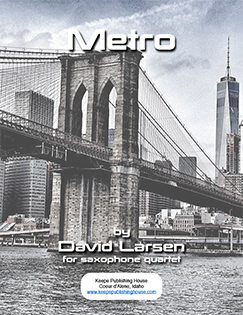 |
Larsen, David -Shufflin’ for saxophone quartet (2012) – 3:46 Minutes (Depending on solos) Program Notes: Shufflin’ is a 12 bar blues with a twist. The piece works best with a full rhythm section but can be performed with only the saxes. You should play this piece with a heavy swing feel and lots of back beat. As the name implies, a good shuffle. The shout sections and counter point are reminiscent of later Bill Holman works and have a nice amount of crunch to the chords. The solos could be played by any member of the ensemble, but features room for Bari Sax specifically. Sample Score Page , Sample Score Page II
Price: $30 USD (Digital Only) |
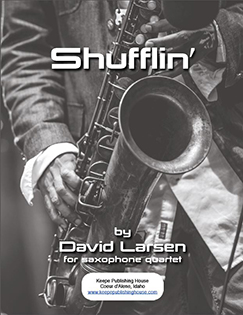 |
Larsen, David - Walking Man or saxophone quartet (2014) – 3:58 Minutes (Depending on solos) Program Notes: Walking Man was written in the style of the great bass player and composer Charles Mingus. The piece features a driving bass line, shocking chords, and lots of improvisation. The group should practice making it as wild and free as possible. No need for sedulity here. Attention should also be made to the group improv sections. Practice playing together to make it feel natural as well as cohesive. It generally works best if everyone has a concept and plays together rather than “at each other. Sample Score Page I, Sample Score Page II
Price $30 USD (Digital Only) |
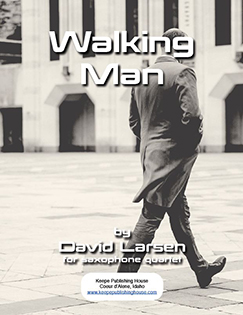 |
Matthews, Wes – Saxophone Quartet No. 1 (2006) 8:23 minutes Sample Score: Page 1, Page 2, Page 3 |
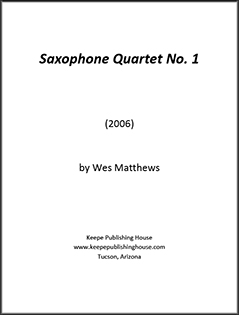 |
| Price: $20.00 (US Dollars) |
Granger, Derek - Fantasia in D minor, K. 397 (ca. 1782) arrangement for saxophone quartet Program Notes: Fantasia in D minor, K. 397 is one of Mozart’s most widely played works for solo keyboard. Despite its popularity, the work is shrouded in mystery. Its exact date of composition is unknown, though most scholars agree that Mozart likely wrote it in early 1782, one year after he moved to Vienna. It was there that Mozart came to admire the masterful counterpoint of J. S. Bach (as well as the emotionally charged, improvisatory keyboard fantasies of C. P. E. Bach) and to absorb the language of the Baroque to the point that he adopted into his own music.
Fantasia in D minor is in three broad and contrasting sections. An introduction of somber arpeggios finishes on the dominant harmony (m. 11), building expectation for the adagio section to follow, which comprises the bulk of the piece. The first theme (m. 12) is poignantly tragic in character, filled with sighing two-note slurs. The striking second theme (m. 20), heralded by repeated notes atop sinking chromatic chords, is like a funerary tolling of bells. Three ensuing presto cadenzas punctuate returns of this melodic material. The final allegretto, set in D major, lifts us from brooding. While its mood does not quite reach full Mozartian joy, its cheerful affect retains a glimmer of the poignance of the first adagio. It is important to note that the final ten measures were composed not by Mozart but by August Eberhard Müller, a musical admirer of his. Why Mozart left the work on a chord that sounds so unfinished (m. 100) may never be known. This arrangement for saxophone quartet bears musical opportunities and challenges. The lyricism and varied colors of the saxophone quartet offer expressive elements that a keyboard cannot achieve. The original key of D minor has been preserved, for reasons mentioned previously. The range of the work fits the modern saxophone quartet well, with the exception of bass notes in m. 11 and at the end of the second presto, which have been notated up one octave in the baritone. A primary challenge will be linking the running notes in each cadenza, without gap or dissonance, between each voice of the quartet. The distribution of notes by instrument reflects musical patterns, and highlights registers of the saxophone that blend most readily. It will be important for each member to know each other part well in order to confidently execute smooth transitions. Articulation and expressive markings were largely left in Mozart’s time to performers (who themselves would have been well enough versed in contemporary practices not to need them). I have added markings in this edition to aid in contemporary performance and mitigate some of the differences between piano and saxophone. Any quartet seeking to perform this work should consult numerous quality recordings in developing their own interpretation, a practice that may very well result in the alteration of some of the printed markings. No matter how the piece is ultimately interpreted, it is important to weave the contrasting sections into a coherent musical whole, one that uses silences with as much purpose as the notes themselves. Final considerations of vibrato usage, timbre, and the like are left to the taste of the performers. |
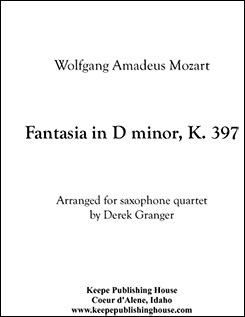 |
| Price: $35 (USD) Digital Download |





